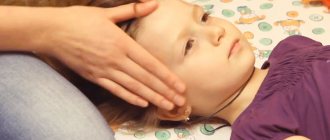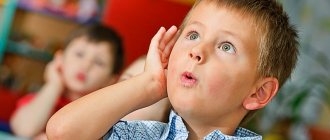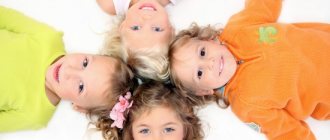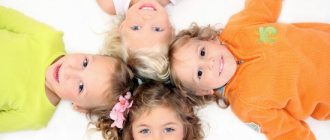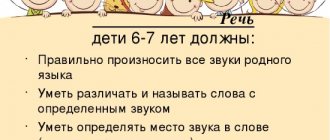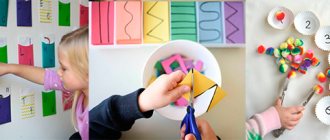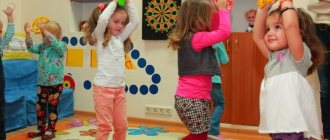Logorhythmic games for children 4-5 years old
By the age of 4-5 years, the final development of speech occurs. It is important to pay great attention to the pronunciation of sounds and strengthening the articulation of sounds. Therefore, speech therapy exercises at this age occupy a special place.
The horse runs tsk-tsk-tsk, (clicking movements of the tongue from the palate)
A bird chirps in a field. (same clicking noise but from teeth)
A friend is sitting on the bank (smile, teeth unclenched)
And catches a fish in the sea (they close and straighten their lips)
Breathing continues to develop. Speech breathing should be distinguished from the general one. You can perform exercises for alternating short and deep breathing:
Doll Masha wants to sleep. (inhale through your nose, exhale with a drawn-out sound “ahhhh”)
Let's sing her a song. (inhale through the nose, on one exhale repeat the syllable “la-la-la” three times)
Doll Masha fell asleep. (sniffle)
The right time for such exercises would be gymnastics after an hour of sleep. Together with general motor skills, fine motor skills are actively developing. It is worth adding acting skills to logorhythmic games and exercises, teaching children to get used to the role and operate with various phrases:
- I am a cheerful cockerel (inhale, exhale “ko-ko-ko”)
I have a comb. (shake head)
— I am a frowning turkey (inhale, exhale “pa-pa-pa”)
I'm looking for grains bale-bale (tilt my head as if pecking at the grains)
- I’m a mischievous horse (clicking tongue from the roof of your mouth)
Golden tail and mane (shake your head)
The expressiveness of movements should correspond to the emotional state of the hero. Children learn to manage their emotions and express them correctly. You can change the exercise words as you play. Let the children do it themselves, do not interfere with their imagination. When the children learn the words, let each of them do the exercises one by one.
Game 1
A good game would be to guess your classmates. It develops tactile sensations, general motor skills and rhythm: children stand in a circle, and one child in the center. He is blindfolded. The children begin to walk in circles. The teacher says “stop” and the children stop. The child in the center of the circle approaches one of the children in the outer circle and guesses who it is.
Game 2
A popular game for this age is “Sea Figure, Freeze!” Children take on the role, play actively, learn to listen to music and quickly respond to brake lights. Freezing in certain positions reinforces knowledge about the capabilities of your body.
Card file of logorhythmic exercises. Card file on speech therapy on the topic
Target:- develop facial expressions;
- learn to clearly pronounce consonant sounds;
-development of prosody
Mirror. Invite children to guess and depict the proposed emotional state (you can use a graphic image, photographs, reproductions, etc.)
Mice. The teacher invites the children to imagine that they have become mice. — the mice walk quietly so that the cat doesn’t hear. We stopped, listened, and moved on. They sniffed it, smiled: it smelled of cheese - they ran to the pantry. We took a bite of cheese. So tasty! We heard a cat sneaking away. They got scared and ran. They ran into the hole. We smiled. And now we will smile at each other.
Bear cubs. The teacher invites the children to imagine that they are bear cubs. — the cubs are walking through the forest, waddling. They saw the beehives - they smiled and licked their lips. I really wanted honey! We came closer, but then the bees swooped in. The cubs frowned and began to wave away the bees, because they bite painfully. We quickly ran away from the dangerous place. They breathed a sigh of relief: they ran away from the bees. We smiled at each other.
Wizards. The teacher invites the children to imagine that they have become wizards and can look into any fairy tale. The children move quietly around the room.
- look where we got to. See how everyone is pulling the turnip together, let’s help them, let’s smile at them. Let's go to another fairy tale. Here Little Red Riding Hood met the wolf. They were afraid for her and shook their finger at the wolf. But we know that everything will end well. Let's look here. How scary! Baba Yaga flew by in a mortar - we got scared and waved our hands. We returned to the group. We smiled at each other.
Mother sleeps. The teacher invites the children to imagine that they are in the room where their mother is sleeping.
- We walk around the room quietly - mom has fallen asleep. Smile at mom! Suddenly a dog barked loudly on the street. They frowned, shook their finger - don’t bark, the dog, mom is sleeping. We walk around the room quietly, without making noise. Mom woke up - smile at mom! Smile at each other!
Astronauts. The teacher invites the children to imagine that they have become astronauts.
— The astronauts will have to fly on a spaceship. We are in spacesuits, it is difficult to move on the ground in them. The astronauts say goodbye to the earth - they wave to everyone. We flew - a little scary. We flew to the moon. How interesting! We are surprised. On the moon we easily jump from stone to stone. We looked at everything, studied it, and wanted to go home. We returned to earth and smiled!
Fluffy kitten. The teacher invites the children to imagine that they have a fluffy little kitten in their arms, stroke it, listen to how it purrs. - Now let's play with the kitten. We have a bow on a string, the kitten runs after the bow, reaches for it, jumps, and we raise and lower the string. Have fun playing with your kitten!
Logorhythmic games and exercises for children 5-6 years old
At this age, children, as a rule, already speak well and know how to control their body. The child's body is full of strength and energy. Active games and exercises that require physical effort are suitable. To prepare for beautiful handwriting, logarithmic exercises for fine motor skills and self-massage (rubbing palms, fingers, acupressure exercises) are used.
It’s not for nothing that winter is angry, (shaking index finger)
Its time has passed. (rubbing palms)
Spring is knocking on the window (knock on the palm with a finger)
And drives them out of the yard (waving their arms, driving away winter) (F. I. Tyutchev)
Logorhythmics at this age should be aimed at developing a sense of rhythm and emotion in speech, and correct intonation. At 5-6 years old, you need to teach your child smooth speech and voice, and continue to develop breathing. During the year there is active preparation for school. With the help of logorhythmic exercises, attention and concentration are developed.
Transitions of music tempos from slow to fast and back are relevant at this age. To gain a sense of rhythm and tempo, you can let children play musical instruments themselves and beat out a simple rhythm together, for example, on spoons and tambourines. In the older group, exercises are of a regulatory nature. Teach children independence. Exercises where the child himself must guess what movement needs to be made at the moment are well suited for these purposes. For example, when you hear the words “snowflakes are spinning,” you need to spin around with your arms out to the sides:
All the snowflakes are whirling in the wind, (whirling)
Without doubts and worries. (jump, breathe through their nose)
So we guys are together (holding hands)
Together we will stand in a round dance (they walk a circle in a round dance) (M. A. Mordvin)
The help of a teacher is required when performing the exercises for the first time.
What is logorhythmics and why is it needed?
Logorhythmics, also known as speech therapy rhythmics, is a set of exercises that combine movements, music and short poems. Classes are held in a playful way, which brings a lot of pleasure to children.
Logorhythmics classes are very useful and produce a lot of positive effects:
- the child develops a sense of rhythm;
- orientation in space improves;
- the child learns to control his body better;
- auditory attention and hearing in general develops;
- vocabulary is expanding;
- the child is accustomed to physical activity and, as a result, to a healthy lifestyle;
- facial expressions improve.
Also, do not forget about pleasant bonuses - in the form of another opportunity to have fun and interesting time with your baby and the pleasant emotions that your child will receive in the process of practicing logorhythmics.
Logorhythmic games for children who stutter
Logorhythmic exercises for children with stuttering include complexes that strengthen muscle tone, articulation, and diaphragmatic breathing. All exercises must be agreed upon with a speech therapist. Children with speech impairments require a special approach, cannot master musical exercises in full, and require repeated repetition of rhymes and songs. Be sure to pronounce each sound:
The children have a doll in their hands. They clearly pronounce the sounds with the correlation of the action in verse to the doll:
Masha washed Mila with soap.
Exercise:
We put a lock: (smile, teeth closed)
The tongue couldn't get through. (tongue rests on teeth)
The main goal of such games for children with stuttering is to develop the tempo of speech, the rhythm of movements, the smoothness of the voice and coordination in a static and dynamic position. In addition to the speech therapy part, the classes are socially adaptive in nature. They teach behavior in a team, develop the emotional-volitional sphere. This includes activities that transition from a slow walk to running:
Early in the morning they go to visit -
Only best friends. (hugs with a classmate standing next to him)
Turtle with a thick cane
It was not in vain that I set off on my journey. (slowly raise their legs, imitate a step)
The little squirrel called all the animals,
I distributed invitations. (bows in different directions)
Mouse, bear and little rabbit (mouse - walk on tiptoes, bear - clumsily, little rabbit - jump)
They dressed up like they were going to a ball. (make a bell with your hands)
The fox is running as fast as he can - (imitate running)
After all, you can't be late. (they shake their index fingers alternately)
To dance around
Sliding smoothly across the floor. (spinning)
(M. A. Mordvin)
From smooth hand movements to fast ones:
They barely tilt
They ate the tops of their heads straight to the ground. (slowly swing your arms up and down while leaning forward)
A bird flutters in the sky,
Like an eyelash above an eye (stand on tiptoes, quickly wave your arms)
(M. A. Mordvin)
It is advisable to perform the exercises with a music teacher accompanied by live music that is not distorted by the recording. Acting games are performed together with the teacher. First, collective performances or performances without the children’s words are performed, then each child is invited to learn his own words and act out a short story. Words must be selected strictly according to the characteristics of each child and have a focus on those parts of pronunciation that require increased attention. Thus, a collective lesson turns into an individual one.
Relaxation exercises are performed in conjunction with exercises that require increased load. Such games and activities should alternate. The relaxation exercise should be proportionally equal to the load received by the children in the previous game.
Logorhythmic exercises for preschoolers
Author: Alexandrova Alexandra Evgenievna music director of the GBDOU kindergarten No. 4 of the Krasnoselsky district of St. Petersburg
Description of work: I bring to your attention logorhythmic exercises that can be used by preschool teachers and specialists, primary school teachers and parents. Goal : To develop manual motor skills and coordination of speech with movements. Objectives : development of vocabulary and attention, encouragement for active creative activity Logorhythmic exercises
“Snowman”
One hand -
stretch your right hand forward
Two hands -
stretch your left hand forward
sculpt a snowman -
“make a lump”
Draw a wider mouth - draw
a line opposite your mouth
Take coals for the eyes
- “take” coals from your palm and place them in turn opposite yours eye
And put on a hat -
“put on a hat”
Slant
- tilt your head
.
Let him laugh with us! — fold your palms into a “shelf” under your chin and smile with alternating head tilts
“Nettle”
In the garden -
stretch your arms forward
Lonely -
hug yourself
Sad -
swaying your body
Nettle
- raise your outstretched palms
.
Maybe she’s offended by someone? - raise your shoulders
I’ll come closer! -
steps in place
But she’s angry -
stretch her right hand forward carefully and put it behind her back.
She burned my hand -
carefully stretch her left hand forward and put it behind her back.
Oh! -
clap and blow on hands
"Ball"
We quickly inflate the balloon -
“inflate” the balloon.
It becomes big -
spread your arms wide to the sides.
Suddenly the balloon -
stretch your arms forward.
Burst -
pop
.
The air has come out, lower your hands down and squat with the sound shhhhh
.
He became thin - stand up and show a pinch with his right hand
, and thin -
show a pinch with his left hand
.
"Geese"
The cold weather has arrived -
hug yourself.
The leaves are flying away -
raise your hands up and smoothly lower them down with the rotation of your hands
.
Well, and the geese by the pond - put your hands down with your palms raised and sway in place,
walk barefoot! -
wave your arms to the sides
, lest you get sick -
threaten with the index finger of your right hand
.
Look how red the paws are! - they threaten with the index finger of their left hand
.
"Jellyfish"
A jellyfish swims in the sea -
smooth movements of the hand.
Its belly is transparent -
turn the palm up
.
And it itself is like jelly - shake your palm
.
Take it in your hands - stretch your arms forward.
Let's not -
hide your hands behind your back and shake your head.
"The bear is drinking tea"
The bear drinks hot tea -
cup your hands like a saucer, blow and drink
And sucks candy -
lower your hands, “take the lollipop” and smack
.
Don’t get wet by accident! - threaten with your finger.
Tie a napkin -
“tie a napkin behind your head
.
"Sly Cat"
The cat lapped the milk,
fold the palms of your hands into a “saucer” and tilt your head down towards your palms.
And left it,
stretch the “saucer” forward
a little,
show a pinch with your fingers
.
Let her wave her hand forward
, she thought,
shaking her head left and right
.
The mouse will drink it all to the bottom; fold your palms into a saucer and tilt your head down towards your palms
.
And I , point at myself with my hand.
Look,
fold my palms into a “shelf” under my chin
.
We recommend watching:
Games on a tourism theme for older preschoolers Logorhythmic exercises in verse for su-jok therapy on the lexical topic “Autumn” Logorhythmic exercises in verse for children 5-7 years old on the topic “Vegetable Garden” Logorhythmic exercises in verse for children 5-7 years old on the topic “ Garden"
Similar articles:
Outdoor games for children from 3 to 5 years old
Games for attention
Word games for preschoolers
Tricks for children 4-7 years old in kindergarten
Assignments on the topic “Fruits” for children 5-8 years old

